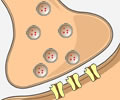Chapter 1. Structure of a Synapse
1.1 Structure of a Synapse
Function of each structure associated with this synapse:
axon: carries signals from the cell body to the axon terminal
neurotransmitters: chemical messengers that are released into the synaptic gap
synaptic vesicles: small membrane sacs that contain neurotransmitters
axon terminal: forms a junction with the dendrite of the receiving neuron
receptor site: binds with the neurotransmitter; influences the new electrical signal
synaptic gap: the physical space between two neurons; also called the synaptic cleft
dendrite of receiving neuron: receives signals from other neurons
1.2 Structure of a Synapse
Most neural communication begins with the release of chemical neurotransmitters from the axon terminal.
The axon terminal of this neuron has formed a synapse with the dendrite of another neuron. As you zoom in for a closer look, notice the receptors on that dendrite's membrane surface.
Inside the axon terminal, tiny sacs called synaptic vesicles hold the neurotransmitters.
When stimulated, the vesicles migrate toward the axon's presynaptic membrane, and release their neurotransmitters into the synaptic gap.
Neurotransmitters travel across the synaptic gap to the postsynaptic membrane, where they bind to receptor sites. Individual neurotransmitters bind only to receptor proteins designated for that particular chemical structure.
The neurotransmitters bind with specialized receptors on the postsynaptic membrane of the next neuron. This causes the next neuron to generate its own neural impulse.
1.3 Explain. Structure of a Synapse

Neurons interweave so intricately that even with a microscope it is hard to see where one neuron ends and another begins. We now know that the axon terminal of one neuron is in fact separated from the receiving neuron by a gap less than a millionth of an inch wide. The junction of two neurons is called the synapse, and the gap between them is called the synaptic gap or cleft. How do the neurons communicate? The axon terminals of the sending neuron contain synaptic vesicles filled with special chemicals known as neurotransmitters. When the neural impulse (the action potential) from the sending neuron reaches an axon terminal, the vesicles move to the presynaptic membrane, then open up and release their neurotransmitter molecules into the synaptic gap. The neurotransmitter molecules from the sending neuron diffuse across the gap and come to rest on special receptor sites on the postsynaptic membrane of the receiving neuron's dendrite.
1.4 Question
QUESTION: What part of neuron carries signals from the cell body to the axon terminal?
1.5 Question
QUESTION: How are the chemical messengers that transfer signals across a chemical synapse called?
1.6 Question
QUESTION: How is the physical space between two neurons called?
1.7 Question
QUESTION: What forms a junction with the dendrite of the receiving neuron?
1.8 Question
QUESTION: How is the place that binds with the neurotransmitter and receives chemical signals from outside a cell called?
1.9 Question
QUESTION: How are the small membrane sacs that contain neurotransmitters called?
1.10 Question
QUESTION: How are the processes of the nerve cell that receives signals from other neurons called?
1.11 Question
QUESTION: What is the function of axon of the sending neuron?
1.12 Question
QUESTION: What is the synaptic gap?
1.13 Question
QUESTION: What are the neurotransmitters?
1.14 Question
QUESTION: What is the function of the receptor site?
1.15 Question
QUESTION: What is the synaptic vesicles?
1.16 Question
QUESTION: What is the function of dendrite of receiving neuron?
1.17 Question
QUESTION: What is the function of axon terminal?